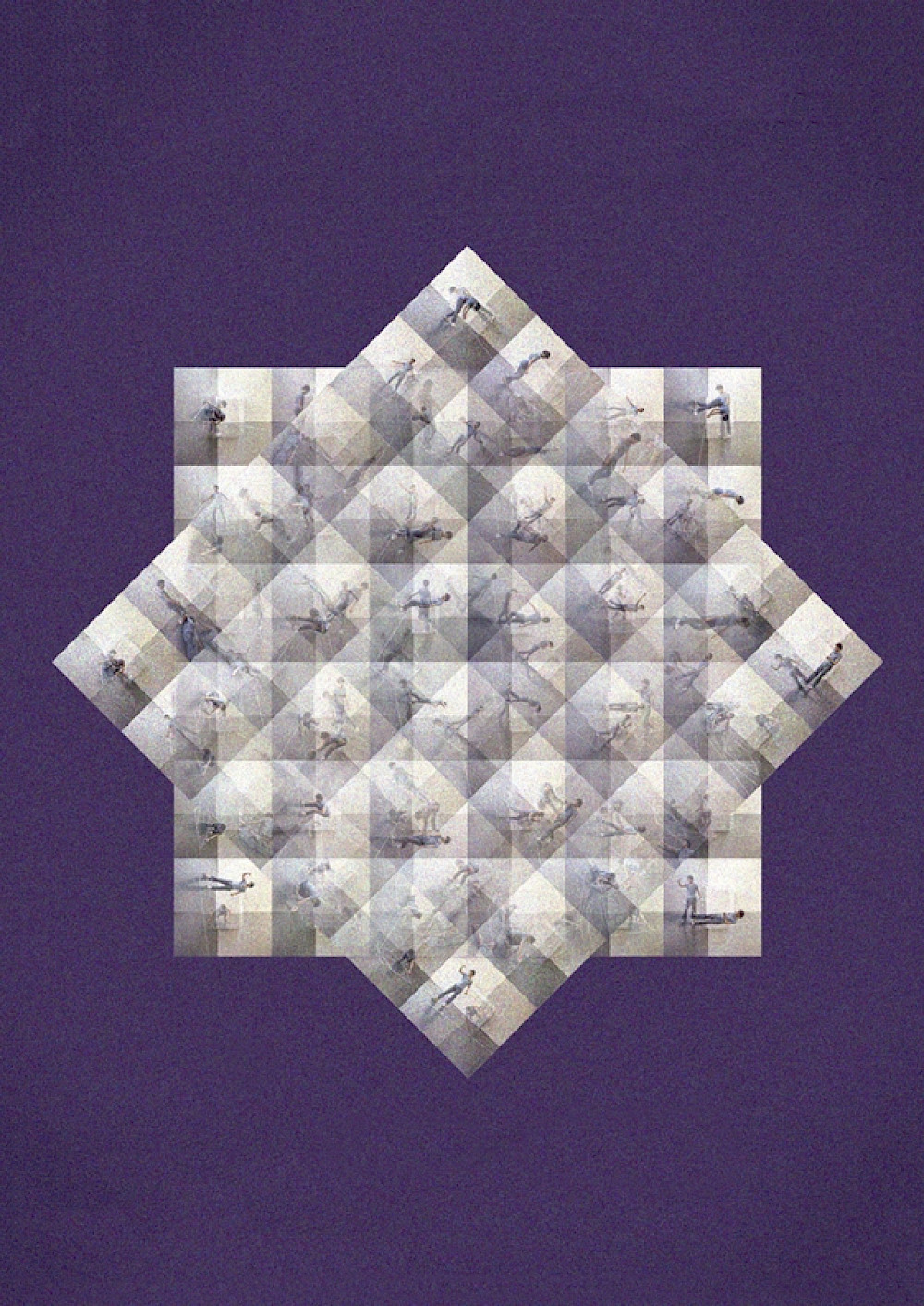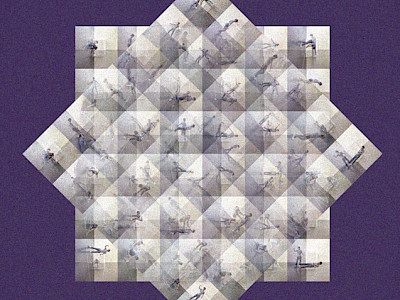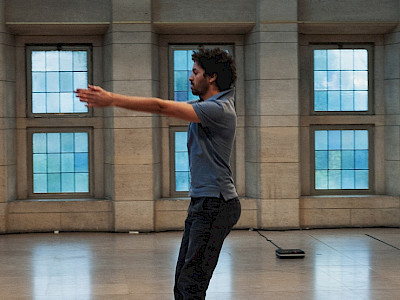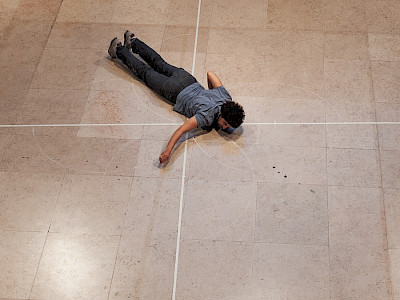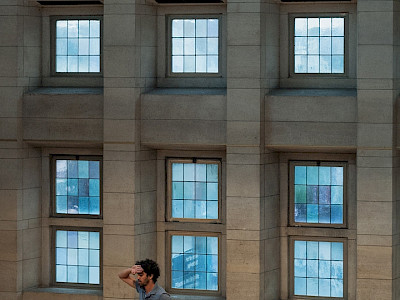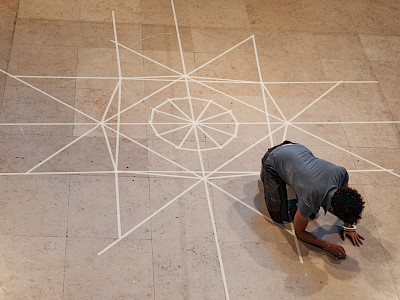21 — 26.05.2015
After training in Marrakech and Tunis, dancer and choreographer Radouan Mriziga moved on to P.A.R.T.S in Brussels. His first creation, ~ 55, is a perfect demonstration of the way in which he has turned the hybrid influences of his dance into a personal language, somewhere between sobriety and sensuality, concept and physicality, structure and sentiment. In ~ 55 , a new version which will be specifically created for the Bâtiment Dynastie in Brussels, Mriziga is responsible for everything: dance, sound and lighting. ~ 55 , like the 55 minutes of an “architectural” show constructed on the number five and the measurements of a dancer’s body. Fascinated by an artisan’s gestures in which movement is organised to serve production, Mriziga uses his body like a tool to produce a pattern on the floor. The forms appear almost inevitably from the relationship between his anatomy and the given space. But here, the rationalist less is more is not incompatible with the aesthetic and emotional delight derived from the ornamental… Superb!
Interview Radouan Mriziga
Radouan Mrziga graduated in 2012 from P.A.R.T.S., Anne Teresa De Keersmaeker’s Brussels dance school. Last season he worked on the presentation Half Elf Zomeravond which Bart Meuleman realised at the Toneelhuis. He is one of the performers of the production Re:Zeitung, a project of the P.A.R.T.S. Foundation and De Munt in which a new generation of professional dancers rework the repertoire of De Keersmaeker. In 2014, he also danced in Primitive, the new production of choreographer Claire Croizé, and rehearsed the young French choreographer Simon Tanguy’s latest creation People in a Field. In the meantime, Mriziga has worked on his first choreography, 55, as an artist in residence at the Moussem Nomadic Arts Centre.
What is it like for a dancer to work on four pieces simultaneously?
Granted, it is not obvious. They are almost four totally different approaches to dance. It requires great physical but also mental discipline. Every piece requires a different performance, another approach. It is a challenge for my body and my mind. I have to stay focused. I am the dancer in three of the pieces. At the same time, I have to find the time and energy to develop my own choreography and be careful that it does not affect the other pieces I work on. It requires special coordination to keep my work in these four pieces in balance.
You began your studies in Marrakech, not really a city one immediately associates with contemporary dance.
That’s right, and yet. In Marrakech you do have a hip-hop and a traditional dance scene. But there is no infrastructure or school for contemporary dance and performance. Now, what attracted me to dance, is movement as such. And in Marrakech, more than in other cities, everything is in constant motion: the architecture, the streets, the people. That has always fascinated me and eventually led me to dance. I had a scientific training and I love brain teasers. At the same time, I am also very interested in all kinds of physical sports. And I feel contemporary dance brings all those things together in an ideal way. It is abstract and pure, and at the same time also very open. It touches upon everything at once. I met Jacques Garros, a teacher in ‘body work’ from Bordeaux, who taught in Marrakech and I worked with him for some time. Then I went to Tunisia for a dance course.
What did you discover there?
It was my real introduction to contemporary dance. I learned the techniques. The Centre méditerranéen d’Art contemporain of Tunis is a small school, but in that region it is an institution. It was a big adaptation for me. I learned how contemporary dancers approach the discipline of dance. After the training, I had the opportunity to start creating work. But I mostly wanted to study more, explore more.
And then you were selected for P.A.R.T.S. How did you get in contact with the Brussels school?
I knew the work of Anne Teresa De Keersmaeker even before I had ever heard of P.A.R.T.S. Belgium has a strong international reputation when it comes to contemporary dance. But I never planned to continue my studies in Brussels. The only thing I knew for sure at that time was that I didn’t want to go to France. Up until then, I had been mainly influenced by the French system and I was looking for something different. The people of P.A.R.T.S. came to the dance festival in Tunis and they talked about their school. I saw it as a distant option, not really real. I followed a number of workshops and while I was working in Marseille I heard that P.A.R.T.S. was having auditions. I applied and was selected for the final audition in Brussels. During the four days of preparation, I really became convinced that this was the right school for me. The approach of P.A.R.T.S. is in line with my own approach to dance.
Did the reality match your expectations?
It was a very influential experience. The training is very intensive, Anne Teresa sets the bar very high. You are not only trained to become a dancer, you are trained as an artist. From my second year at P.A.R.T.S., I really started to think in a different manner, and consequently also started to approach things differently. What I had until then regarded as dance and performance became something much bigger. I learned to open myself to theatre and singing. I discovered compositions, studied music, art history, history of dance, … many new possibilities opened up to me. It was as if I was suddenly given more ‘tools’. I come from a very musical, rhythmic culture. But I never found the right way to engage with it. To really touch the music. I was familiar with the rhythm, I understood the music, but it felt like something natural, something I was born with. I never learned how I could really use music as a performer. In Belgium I was confronted with a totally different musical culture and that enabled me to approach my own musical background in a different manner. I learned to understand the structure, separate the rhythm from the melody. That was very radical.
You dance in Re:Zeitung, a new version of a true classic from the repertoire of De Keersmaeker.
Everyone danced the repertoire in the school and I really liked that part of the training. You touch upon the history and become part of something that originated a long time ago. I feel very strongly connected with this work. Anne Teresa’s choreographies are a pleasure to dance. But it is not the only thing I want to do. I am currently working on my first choreography since finishing my studies.
A solo. Was that a conscious choice?
The concept of this solo was actually born from a kind of basic need. I wanted to make my own creation, while interpreting the work of others. I did not really have the means and I decided to limit myself to a research project. Moussem was willing to support it. From the outset, the whole concept was based on functionality and simple basic principles which naturally led to a solo.
You have worked on it in since July 2013.
As I look back on the process, I find that it might not be the best approach to work on it with such long periods in-between. On the other hand, the whole creation grew out of a study. At that time it was not yet certain that it would become a piece. It was only at the presentation of the study that it became clear that it had potential. Moussem offered me the opportunity to carry on working, and since February 2014 I have been developing it as a full performance.
What is the piece about?
The starting point of 55 is: how can I be as functional as possible on stage? As a dancer you constantly ask yourself questions. Is it sufficient? Is this what I want to convey? Is this the right form? What exactly am I doing? What am I making? What do I express? I set out in search of functionality and the form functionality may adopt. It is an almost architectural approach. I question myself as a performer and as a creator. What happens when I have no tools at my disposal? No scenography, no theatre lighting, no video, no music, no money? How can I still make something interesting, something that will captivate people for at least twenty to thirty minutes?
Motion and form are still at the centre of your interest?
I can really enjoy exuberant performances, but I rather tend toward minimalism. Extravagance does not serve my purpose. I spent a lot of time observing artisans and architects. Architecture is, in essence, functional form. At best, it is also interesting in terms of aesthetics, but functionality remains its most important aspect. Artisans use their body in the service of form, they move in a particular manner that leads to the creation of a form. Sometimes they make the same motion for a whole day. This observation led me to understand why architecture appeals to me. Obviously, this is nothing new, many dancers and choreographers are interested in architecture. Of course, I am influenced by the Maghrebian school (the geometric approach), but at the same time I am quite fond of Western minimalism. As with music, I remained an outsider for a long time, I looked at it and that was it. I have now learned how to use those things and how to bring them together.
Moussem Journaal #3 September 2014
Concept created & performed by
Radouan Mriziga
Assistance
Alina Bilokon
Acknowledgments
Moussem team, Alina Bilokon, Youness Khoukhou, Christophe Dupuis, Bart Meuleman, Steven De Belder
Presentation
Kunstenfestivaldesarts
Production
Moussem Nomadic Arts Centre
Co-production
C-mine cultuurcentrum (Genk), WP Zimmer (Antwerp)
Supported by
Cultuurcentrum Berchem (Antwerp), Pianofabriek Kunstenwerkplaats (Brussels), STUK Kunstencentrum (Leuven), O Espaço do Tempo (Montemor-o-Novo)
Thanks to
Régie des Bâtiments/Regie der Gebouwen
